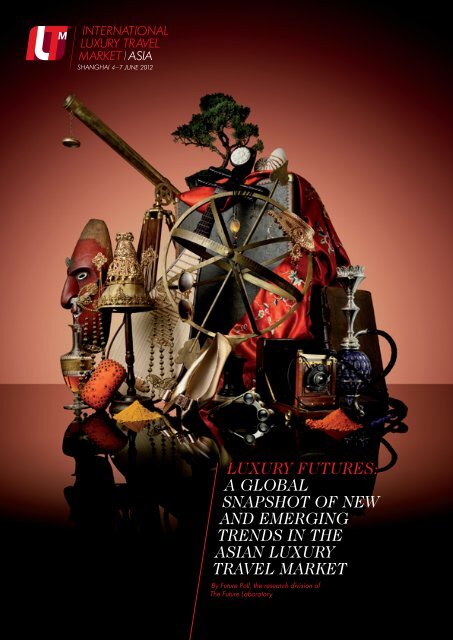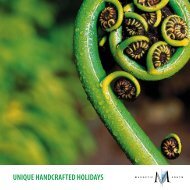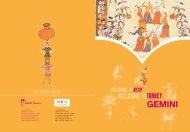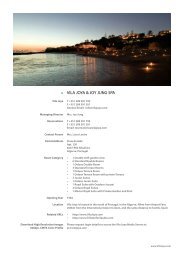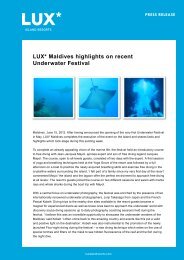A GLobAL SnApshot - International Luxury Travel Market
A GLobAL SnApshot - International Luxury Travel Market
A GLobAL SnApshot - International Luxury Travel Market
Create successful ePaper yourself
Turn your PDF publications into a flip-book with our unique Google optimized e-Paper software.
<strong>Luxury</strong> Futures:<br />
A gLobAL<br />
snApshot oF new<br />
And emerging<br />
trends in the<br />
AsiAn <strong>Luxury</strong><br />
trAveL mArket<br />
By Future Poll, the research division of<br />
The Future Laboratory
01<br />
Future Poll : the research division oF the Future laboratory
Opposite page from<br />
clockwise top left: Raffles<br />
Hotel, Singapore; Selfridges<br />
Womenswear Designer<br />
Galleries, London; W retreat<br />
and spa, Seminyak, Bali;<br />
Ulpotha, Sri Lanka; Vivanta by<br />
Taj Yeshwantpur, Bangalore;<br />
Song Saa, Cambodia; Hotel<br />
ICON<br />
03<br />
04<br />
05<br />
09<br />
11<br />
25<br />
33<br />
contents.<br />
IntroductIon<br />
Methodology<br />
overvIew<br />
luxury travel drIvers<br />
new asIan luxe travellers<br />
asIan travel Futures<br />
Key taKe-outs<br />
iltM asia : luxury travel Futures<br />
02
03<br />
introduction.<br />
Asian luxury travellers are a ray of optimistic light amid<br />
the gloom of global economic turmoil. Protected from<br />
recession by economies in good health, they desire<br />
experiences and are using their social media savvy to find<br />
unusual and rewarding travel experiences.<br />
New luxury travel tribes are emerging, representing exciting<br />
and significant opportunities for the brands that can meet<br />
their challenging and sometimes contradictory demands.<br />
W retreat & spa, Seminyak, Bali<br />
Future Poll : the research division oF the Future laboratory
methodoLogy.<br />
This report by Future Poll, the research division of The<br />
Future Laboratory, was commissioned by <strong>International</strong><br />
<strong>Luxury</strong> <strong>Travel</strong> <strong>Market</strong> to investigate and forecast new and<br />
emerging trends among Asian luxury travellers.<br />
In-depth interviews with leading industry experts and<br />
analysts were combined with extensive desk and visual<br />
research to produce a qualitative report that identifies key<br />
drivers, and paints a nuanced picture of the affluent travel<br />
tribes that exist across national borders and demographics.<br />
The Governor’s Residence, Myanmar<br />
The experts who offered informed<br />
and thought-provoking perspectives<br />
on the future of the Asian luxury<br />
travel market were:<br />
Alison Gilmore, exhibition director,<br />
<strong>International</strong> <strong>Luxury</strong> <strong>Travel</strong> <strong>Market</strong> (ILTM)<br />
Doris Goh, vice-president, sales and<br />
marketing, Alila Hotels and Resorts<br />
Richard Hatter, general manager,<br />
Hotel ICON<br />
Gabriela Henrichwark, group<br />
marketing director, COMO Hotels<br />
and Resorts<br />
Nigel Horne, senior vice-president<br />
sales and marketing, APAC and The<br />
Americas, Kuoni Global <strong>Travel</strong> Services<br />
Lim Hui-Juan, director and cofounder,<br />
Quotient <strong>Travel</strong>planner<br />
Vikram Madhok, managing director,<br />
Abercrombie & Kent India<br />
George Morgan-Grenville, founder<br />
of Red Savannah<br />
Priya Paul, chairperson, Apeejay<br />
Surrendra Park Hotels<br />
Marion Walsh-Hédouin, group<br />
director of public relations, Anantara<br />
Hotels, Resorts & Spas<br />
iltM asia : luxury travel Futures<br />
04
05<br />
overview.<br />
It is often said that the devil is in the detail, and that is certainly true for any<br />
brand seeking to address the desires and demands of the Asian luxury<br />
traveller. It is also tempting to envisage Asian affluents as a homogenous<br />
whole, or to make assumptions about their level of sophistication or<br />
expectations based on their country of origin.<br />
Such assumptions must be set aside, as Asian travellers are united by<br />
their level of earnings, their online awareness, and a desire for new<br />
experiences, rather than by their place of birth. We have identified the<br />
luxury travel tribes which are shaping the present and will become even<br />
more influential in the future as follows:<br />
• New Sophisticates are rejecting ‘vanilla’ trips to tried-and-trusted<br />
destinations in favour of Yangtze River cruises, holidays on the<br />
Galápagos Islands and high-end safaris, demonstrating their newly<br />
found connoisseur sensibilities.<br />
• Heritage brands and those that can offer exclusive experiences are<br />
capturing the attention of the Status Hunters.<br />
• Online peer-to-peer comparisons are leading the Young Guns<br />
towards adventures at the South Pole and other relatively unexplored<br />
parts of the world.<br />
• In India, Single Saris are on the move, spawning an all-female travel<br />
industry, while <strong>Luxury</strong> Pilgrims are demanding religious pilgrimage with<br />
five-star facilities and services.<br />
• Using their £200,000 wedding budgets, Ultra-honeymooners have<br />
their eyes on Bali, the Maldives and Hawaii.<br />
• China’s Frugal Millionaires are demanding value-for-money luxury.<br />
• Eco-luxury in places such as Cambodia is winning the hearts and<br />
minds of the environmentally sensitive, culturally curious Green Shoots.<br />
• Five-star destinations that will cater for multi-generational, extended<br />
family groups are high on the Luxe Pack traveller’s shopping list.<br />
Future Poll : the research division oF the Future laboratory<br />
Opposite page from<br />
clockwise top left: The<br />
Upper House, Hong Kong;<br />
Selfridges Womenswear<br />
Designer Galleries, London;<br />
W Retreat & Spa, Seminyak,<br />
Bali; Women on Wanderlust;<br />
Ulpotha, Sri Lanka; Song<br />
Saa, Cambodia; Chonge<br />
River House, South Africa
iltM asia : luxury travel Futures<br />
06
07<br />
Future Poll : the research division oF the Future laboratory
The expectations and desires of these influential travellers are shaping an<br />
Asian luxury travel future which is exciting and rich with possibilities, but<br />
full of pitfalls for the unwary:<br />
• High service standards in Thailand and Indonesia are driving Service<br />
2.0, forcing travel brands to step up to the plate across the globe.<br />
However, China is struggling to recruit and train staff who can provide<br />
five-star service.<br />
• The new wave of luxury travellers taking advantage of Asia’s steadily<br />
improving air and transport connectivity means that hotel groups face<br />
a circle of supply balancing act, where they need to provide exactly<br />
the right number of rooms and corresponding facilities.<br />
• Home Comforts are a must for the Asian Luxe crowd. Brands need<br />
to provide familiar food and communicate in visitors’ native language<br />
in a way that is respectful and empowering, not as a patronising<br />
comfort blanket.<br />
• Family First travellers are looking for ultra-luxury destinations that<br />
their young families can enjoy too.<br />
• Time-poor Young Guns want travel brands that will Customise and<br />
Curate the bespoke holiday of their dreams.<br />
• Clean Air Adventurers want to escape polluted major cities in a<br />
search for pristine environments, and a taste of forbidden fruit.<br />
Opposite page from<br />
clockwise top left: The<br />
<strong>Market</strong> Sushi Station, Hotel<br />
ICON; The Hualuxe Brand by<br />
IHG; Cox and Kings Family<br />
Holiday; DDB Canada; The<br />
Strand, Myanmar<br />
iltM asia : luxury travel Futures<br />
08
09<br />
<strong>Luxury</strong> trAveL drivers.<br />
recession resistance<br />
The UK’s GDP shrank by 0.2% in the first quarter of 2012,<br />
according to the Office for National Statistics, plunging<br />
the country into its second period of recession in three<br />
years, and many eurozone countries are also struggling.<br />
However, the situation in Asia is different.<br />
‘It is well known and reported that Asia is a huge area<br />
of economic growth in the world and that Western<br />
consumers are still suffering from the global recession,’ says<br />
Gabriela Henrichwark, group marketing director, COMO<br />
Hotels and Resorts. ‘Naturally this has had a positive effect<br />
on spending power for travellers residing in Asia.’<br />
China is a case in point. The country is home to more<br />
than 500,000 people with disposable assets of $1.6m,<br />
according to the 2011 China Personal Fortune Report. In<br />
2012, China has 4,000 yuan billionaires, according to<br />
the Hurun Report. Consequently, the number of Chinese<br />
outbound tourists rose by 22.42% in 2011 to 70.25m,<br />
according to the National Tourism Administration of China.<br />
Future Poll : the research division oF the Future laboratory
experience-seeking<br />
A global hunt for bling by Asian luxury travellers is<br />
beginning to evolve into a desire for rare and rewarding<br />
experiences. ‘With regards to aspirations and desires,<br />
high-net-worth individuals in China are starting to spend<br />
more on experiences, including travel and wellness,<br />
as opposed to luxury goods such as fashion and<br />
handbags,’ says Henrichwark. ‘Key drivers in consumer<br />
spend are now more skewed towards experience and<br />
self-reward as opposed to being status-symbol driven.’<br />
Doris Goh, vice-president, sales and marketing, Alila<br />
Hotels and Resorts, sees the same profound shift. ‘China<br />
is the key driver of global luxury. The country has an<br />
estimated 250m people defined as buyers of luxury<br />
who are following the Western trend of spending for<br />
experiences in their travel preferences,’ she says.<br />
Media explosion<br />
Asian luxury travellers are social network<br />
veterans. They scour peer-to-peer reviews<br />
and comparison shop before making their<br />
travel decisions.<br />
‘With the explosion of social media in<br />
the past five years, views and opinions of<br />
travellers and well-known figures are shared<br />
through sites such as Sina Weibo, Facebook,<br />
Twitter and TripAdvisor,’ says Henrichwark.<br />
‘The result is an incredible transparency for<br />
products, services and experiences. Whether<br />
they are looking for a handbag in Paris or a<br />
week in the Maldives, consumers can make<br />
an informed decision on all purchases. It<br />
is therefore vital that all companies follow<br />
through on their brand offerings and promises.’<br />
Goh agrees about the importance of online<br />
interaction: ‘It will be increasingly difficult to<br />
keep the luxury travel experience fresh and<br />
unique and to maintain market distinction.<br />
Companies will need to communicate with<br />
customers through the growing number of<br />
digital media platforms.’<br />
Left to right: Mandarin<br />
Oriental Hotel, Sanya;<br />
Ulpotha, Sri Lanka; Digital<br />
Art Wall, Selfridges Galleries<br />
changing rooms, London<br />
iltM asia : luxury travel Futures<br />
10
11<br />
new AsiAn Luxe<br />
trAveLLers.<br />
Any remaining belief that Asian luxe<br />
travellers are a homogenous mass<br />
whose hopes, dreams and desires can<br />
be stereotyped purely by their country<br />
of origin are finally laid to rest by the<br />
emergence of new tribes that cut across<br />
borders and demographics.<br />
new sophisticates<br />
Future Poll : the research division oF the Future laboratory<br />
A growing and influential minority in China, India and<br />
Indonesia, New Sophisticates are seasoned travellers<br />
who see experience as status. Hotels such as Raffles<br />
in Singapore, with heritage tales to tell, and one-off<br />
boutiques such as The Upper House in Hong Kong, are<br />
typical of their accommodation of choice.<br />
‘Istanbul, offering ancient culture at the end of a four-hour<br />
flight, is a very hot destination with the discerning highnet-worth<br />
individual from India. South Africa is starting to<br />
appear on their radar too,’ says Priya Paul, chairperson of<br />
Apeejay Surrendra Park Hotels (The Park Hotels’ chain of<br />
boutique hotels) and a prominent entrepreneur in India.<br />
‘The day of the vanilla holiday destination is gone,’ says<br />
Vikram Madhok, managing director, Abercrombie & Kent<br />
India. ‘Indian luxury travellers are buying experiences now,<br />
not mere destinations.
So, they will book a specific high-end spa hotel in<br />
the Cotswolds, a golf break at a hotel attached to a<br />
famous course in Scotland, or a gourmet wine and food<br />
appreciation week in Tuscany. Their spend per night<br />
has risen from £300 per person to £700, and we are<br />
seeing double-digit growth in our outbound business.’<br />
The New Sophisticates are becoming more adventurous<br />
too. ‘We are seeing cruises on the Yangtze, luxury<br />
tented safaris in Botswana rather than Kenya, and trips<br />
to the Galápagos Islands,’ says Madhok.<br />
<strong>Luxury</strong> travellers from Singapore and Indonesia are<br />
targeting European cultural centres that have an edgier<br />
feel. ‘Croatia and Montenegro are becoming popular,’<br />
says Lim Hui-Juan, director and co-founder of Quotient<br />
<strong>Travel</strong>planner, a bespoke travel concierge. ‘They don’t<br />
want to tick the boxes with Paris and London any longer.<br />
They are intrigued by countries full of rich European<br />
history and culture, and some that have<br />
recently been touched by war. They are<br />
looking for authenticity and uniqueness in a<br />
destination.’<br />
Goh backs this up: ‘We are seeing the<br />
emergence of a super-active, independently<br />
minded, educated traveller. They want an<br />
authentic travel experience which is highly<br />
personalised, regardless of price.’<br />
George Morgan-Grenville, founder of Red<br />
Savannah, a bespoke travel specialist which<br />
has Chinese, Indian, Malaysian, Thai and<br />
Indonesian clients, agrees: ‘We have just<br />
organised an ultra-bespoke £300,000 safari for<br />
a Beijing businessman and 10 of his associates,’<br />
he says. ‘It involves travelling by helicopter and<br />
bi-plane and bringing down an elephant with<br />
a tranquiliser dart to put a tracking collar on it,<br />
things that no average safari-goer would ever<br />
dream of seeing and doing.’<br />
Service expectations are often high among<br />
New Sophisticates. ‘Many Indian luxe<br />
travellers are familiar with European and<br />
North American service standards and are<br />
accustomed to hired help in the home,’ says<br />
Madhok. ‘Consequently they demand high<br />
levels of service above all else from their hotel<br />
or resort brand of choice.’<br />
Left to right: Stamford Raffles<br />
Dining Room, Raffles Hotel,<br />
Singapore; The Upper House,<br />
Hong Kong; The Long Bar,<br />
Raffles Hotel, Singapore<br />
iltM asia : luxury travel Futures<br />
12
13<br />
status hunters<br />
Status Hunters are brand-conscious consumers who<br />
make up the majority of the luxe market in India, China<br />
and Indonesia. They want to keep up with the very rich<br />
Joneses by visiting marque hotels in Europe and the US.<br />
‘Often they travel to shop at stores in Europe and the<br />
US because this allows them to demonstrate their brand<br />
status. It also shows that they are value-savvy because<br />
retailers abroad sell iconic names at lower prices than<br />
brand flagships in Shanghai and Mumbai,’ says Nigel<br />
Horne, senior vice-president sales and marketing, APAC<br />
and The Americas, Kuoni Global <strong>Travel</strong> Services.<br />
‘Around 25% of Kuoni’s business in Asia consists of luxury<br />
travellers booking five-star hotel stays for this purpose.’<br />
Breathtaking overseas shopping splurges are the<br />
hallmark of the Status Hunter. ‘I recently met a group<br />
of Chinese high net worths, four women and a man,<br />
who had spent between $20,000 and $30,000<br />
each in Paris in just three days on luxury brand goods,’<br />
says Morgan-Grenville. ‘You cannot overestimate the<br />
obsession with the Hermès Birkin bag in China right<br />
now. People travel the globe looking for brands that<br />
epitomise rarity in order to demonstrate their own status.’<br />
Chinese Status Hunters in particular are exhibiting the tendency<br />
of European and US affluents to seek out brand narratives<br />
to reinforce their own sense of a product’s status value.<br />
‘They want a travel company to arrange for them to see<br />
behind-the-scenes, to allow them to explore the artisan<br />
qualities of high status items,’ says Morgan-Greville. ‘So,<br />
they want to see the workshop at Asprey and to watch<br />
craftsmen working leather and making jewellery by hand.’<br />
Future Poll : the research division oF the Future laboratory<br />
This group’s influence in Europe and the US<br />
can be seen in the way retailers and even<br />
governments are responding and benefiting.<br />
Harvey Nichols, an upmarket department<br />
store in London, saw post-tax profits rise 32%<br />
in December 2011, mainly as a result of<br />
Christmas spending by Chinese customers,<br />
according to a company spokesman.<br />
Selfridges, another luxury store in London,<br />
began accepting China UnionPay cards<br />
in 2011 to cater for a huge increase in<br />
Chinese customers, according to ChinaDaily.<br />
com, while the store’s Manchester branch<br />
has introduced Mandarin lessons for staff.<br />
In February 2012, US president Barack<br />
Obama ordered the Department of Homeland<br />
Security to make plans to reduce visa<br />
application times for Chinese visitors from<br />
four months to three weeks. He believes this<br />
will boost the economy by $850bn a year<br />
by 2020 and will create 1.3m retail jobs,<br />
according to Bloomberg Business Week.<br />
Similarly, Australia is attracting significant<br />
numbers of Asian affluents after making<br />
it easier to get visas, says Morgan-<br />
Grenville, who thinks the UK could do<br />
more to attract visitors from Asia. ‘The UK<br />
insists on the completion of a 13-page<br />
application form, backed up by reams of<br />
official documentation. Chinese travellers in<br />
particular are antagonised by this,’ he says.
Selfridges Womenswear<br />
Designer Galleries, London<br />
iltM asia : luxury travel Futures<br />
14
15<br />
young Guns<br />
Young populations in China, India and Indonesia are<br />
producing a wave of 20 and 30something luxury<br />
travellers. In the US, 50% of Class As (adults with<br />
incomes 200% higher than the average gross salary)<br />
are over 50, according to Euromonitor. In China, 70% of<br />
Class As are under 50.<br />
‘The 35–44 age group is growing rapidly due to the<br />
rising affluence of young business executives in emerging<br />
Asian economies,’ says Goh.<br />
According to Paul, there is a large increase in teenage<br />
and 20something Indians who are travelling alone:<br />
‘Aged 18 to 21, they are the adventurous children of<br />
entrepreneurs who travel to destinations and to music<br />
festivals without their parents.<br />
‘It has never happened before. They are being given much<br />
more independence, much younger, than the previous<br />
generation and of course they have much, much more<br />
disposable income,’ she says.<br />
Exposed to premium Western lifestyles via the internet,<br />
they aspire to the luxury travel experiences enjoyed by<br />
those in the US and in Europe. They use their digitalsavvy<br />
skills to comparison shop, weighing up value for<br />
money and the overall package before making their<br />
choice, according to Paul.<br />
‘This streetwise traveller is a DIY online search advocate<br />
who will be happiest to find the best possible value, as<br />
they can travel off-season at attractive prices,’ she says.<br />
Future Poll : the research division oF the Future laboratory<br />
Hotel brands are facilitating the Young Guns’<br />
desire for online comparison possibilities.<br />
The Starwood Hotels chain has launched<br />
a lifestyle site for young affluent Chinese<br />
consumers, and its W Hotels brand allows<br />
visitors to post live and unmediated Twitter<br />
reviews on its website.<br />
A newly launched Four Seasons iPad app<br />
also allows live and unmediated customer<br />
reviews, and the company encourages<br />
staff to respond immediately to any posted<br />
complaints or concerns.<br />
Bragging rights to new destinations are<br />
key travel motivators for this group. ‘We’re<br />
seeing increased interest in expeditions to<br />
the North Pole and South Pole among late<br />
30somethings and early 40somethings,’<br />
says Morgan-Grenville. ‘They are attracted<br />
to destinations associated with snow, which<br />
they consider to be extreme conditions<br />
because it is rare where they come from.<br />
This gains them face with friends and<br />
associates. Everyone has been to Mauritius,<br />
but telling guests at a dinner party that you’ve<br />
just returned from Mustang, northwest of<br />
Annapurna, bestows major bragging rights.’
Clockwise left: W retreat<br />
& spa, Seminyak, Bali;<br />
W Residences Screenshot;<br />
iltM asia : luxury travel Futures<br />
16
17<br />
single saris<br />
A new generation of middle class Asian career women is on the move, with<br />
the independence, confidence and financial clout to travel solo.<br />
In India, domestic travel brands have not been slow to notice this expanding<br />
new market. Women on Wanderlust (WOW) is just one of several Indian<br />
travel agencies set up to cater for lone female travellers. Others include Girls<br />
on the Go, which is run by Piya Bose; Shireen Mehra’s Women on Clouds;<br />
Kesari My Fair Lady, which is headed by Veena Patil, and Asmeeta Jacob’s<br />
<strong>Travel</strong> Smart.<br />
All of these companies offer female-only travel packages to Indian and<br />
foreign destinations which are often sold out. Providing safety in numbers,<br />
WOW allows women to meet other like-minded solo female travellers and<br />
to cut costs by sharing rooms. The company uses Facebook and Twitter to<br />
connect to its audience.<br />
The founder of WOW, and a former travel writer, Sumitra Senapata reports<br />
100% growth per year and a wide spectrum of customers: the women are<br />
aged between 26 and 65, and are single, married or divorced. Many are<br />
professionals and some are self-employed.<br />
Leading Indian hotels, such ITC Gardenia in Bangalore, which has sister<br />
properties in India’s major urban centres, are also reaching out to the Single<br />
Saris: with Eva floors reserved exclusively for female guests, they feature allwomen<br />
staff, feminine décor and girly extras such as chick lit and curling irons.<br />
Chinese women are becoming more confident about travelling. ‘Nowadays<br />
the Chinese, and women in particular, have a preference for independent<br />
travel versus group travel,’ says Henrichwark. ‘Independent tourism has been<br />
made much more accessible due to easier visa and passport formalities.’<br />
Future Poll : the research division oF the Future laboratory
Lotus Pavilion ITC Gardenia,<br />
Bangalore; Women on<br />
Wanderlust<br />
iltM asia : luxury travel Futures<br />
18
19<br />
luxury Pilgrims<br />
Religious pilgrimage has never been so popular in India.<br />
In 2010, more than 650m Hindu and Sikh worshippers<br />
set off to pilgrimage sites across the subcontinent, a rise<br />
of 15.5% on the previous year, according to the Indian<br />
government. Adults aged 20 to 30 make up 70% of<br />
India’s religious tourism market.<br />
In India, 87% of the population makes at least one<br />
pilgrimage in their lifetime, while 57% make a religious<br />
trip each year, according to TripAdvisor. The domestic<br />
market for religious tourism is growing by 10% a year,<br />
according to The Bird Group, one of the major hospitality<br />
and travel brands racing to meet rising demand.<br />
Pleasure-seeking pilgrims are aged 20 to 40 and are<br />
upwardly mobile, made rich by India’s booming IT and<br />
service sector. Some have worked and lived abroad and<br />
have mature expectations of the luxury market, according<br />
to Condé Nast <strong>Travel</strong>ler India.<br />
<strong>Luxury</strong> Pilgrims are not content to sleep in a crowded bunk<br />
house or on the floor of a local community centre, says<br />
the Economic Times. They have disposable income and<br />
are prepared to pay for a room in a fashionable hotel<br />
and for fine dining. They may spend an afternoon in a<br />
spa or visit tourist hotspots. More than 96% of pilgrims<br />
combine their religious duties with a trip to a luxury hotel,<br />
beach resort or urban shopping destination, according to<br />
a 2011 TripAdvisor survey.<br />
Future Poll : the research division oF the Future laboratory<br />
A new luxury train service, Deccan Odyssey,<br />
connects Delhi with five of Sikhism’s holiest<br />
places, including Amritsar’s Golden Temple.<br />
The nine-day service is sponsored by the<br />
Punjab Heritage & Tourism Promotion Board,<br />
a region where 60% of the population is<br />
Sikh. Deccan Odyssey has a spa, fine dining,<br />
multiple lounge cars, butlers, libraries and two<br />
presidential suites. It has been sold out since<br />
its maiden voyage in 2010, despite a $750<br />
per seat price tag.
Ulpotha, Sri Lanka<br />
iltM asia : luxury travel Futures<br />
20
21<br />
ultra-honeymooners<br />
‘Rich Indian families think nothing of booking 200 rooms<br />
at a five- star hotel for 400 or more guests, and flying in<br />
entertainment, food, designers and waiting staff,’ says Paul.<br />
Six Senses Zighy Bay in Oman has two private retreats<br />
which are signature Ultra-Honeymoon destinations. Each<br />
comprises two large pavilions which are joined, and there<br />
is a spa, library, infinity pool and a private beach. A<br />
butler is also provided.<br />
Frégate, a private eco-island in the Seychelles, with its<br />
romantic honeymooners lair, Bird’s Nest, hidden in the<br />
treetops amid 140 species of rare tropical birds, could be<br />
on their wish list too.<br />
According to Alison Gilmore, exhibition director,<br />
<strong>International</strong> <strong>Luxury</strong> <strong>Travel</strong> <strong>Market</strong>, Bali, the Maldives and<br />
Hawaii are also high on Ultra-Honeymooners’ wish lists,<br />
and for the Japanese, for some time.<br />
‘Japanese clients are high-value and high-spending, but<br />
expect their cultural expectations to be catered for as part<br />
of the package,’ says Gilmore. ‘That means they expect<br />
a home away from home - Japanese speaking staff and<br />
menus in Japanese available.’<br />
Future Poll : the research division oF the Future laboratory<br />
Fregate, The Honeymoon Bird’s Nest, Seychelles
Frugal Millionaires<br />
China’s self-made millionaires are highly price sensitive.<br />
‘They can be extremely frugal,’ says Gilmore. ‘They may<br />
be making a £50,000 booking but they will shop around<br />
and go to the travel agent down the road if he can offer<br />
the package for £50 less.’<br />
‘Five-star destinations are a difficult proposition for new<br />
money entrepreneurs,’ says Lim. ‘They are still new to<br />
affluence and tend to question just how much value for<br />
money they are getting with the high prices such hotels<br />
are asking them to pay.’<br />
Morgan-Grenville has noted the same traits among<br />
Frugal Millionaires. ‘They may travel with the intention<br />
of spending tens of thousands of pounds on designer<br />
brands, but they will stay at a very average hotel because<br />
the accommodation is not the purpose of their stay and<br />
so they don’t want to waste money on it.’<br />
Another challenge in China is for travel<br />
company and hotel staff to understand and to<br />
meet the expectations of these luxury travellers.<br />
‘<strong>Travel</strong> company staff in China find it incredibly<br />
difficult to empathise with the desires of their<br />
rich clientele,’ says Morgan-Grenville. ‘On the<br />
whole, these Chinese members of staff have<br />
never left their home town, so how can they be<br />
expected to design a luxury trip to Paris for a<br />
multi-millionaire? It’s a situation that offers huge<br />
opportunities to savvy brands that understand<br />
how to strike the balance.’<br />
iltM asia : luxury travel Futures<br />
22
23<br />
Green shoots<br />
Alongside a desire for experience, the first glimmerings<br />
of an environmentally sensitive, culturally curious travel<br />
movement have been detected.<br />
Asian luxury travellers are increasingly aware that they<br />
have rare and exotic destinations on their doorsteps: for<br />
example, Sri Lanka has recently become a key destination<br />
of choice for well-heeled Singaporeans.<br />
‘When the Sri Lankan civil war ended and the beauties<br />
of the country began to feature in travel magazines and<br />
newspapers, eyes were opened to the untouched beauty<br />
just a short-haul flight away,’ says Lim. ‘A hankering<br />
for unspoilt nature is a growing trend and Asians are<br />
beginning to see that they don’t have to travel to the<br />
Amazon to find it. It’s here, in our own backyard.’<br />
Song Saa, a private island resort in Cambodia, is typical<br />
of the brands that Green Shoots travellers are seeking.<br />
It has funded waste-management systems for nearby<br />
villages and has set up a local school providing free<br />
education. It also has an in-house marine biology team<br />
which safeguards wildlife and water quality.<br />
Curiosity about their ethnic heritage is also<br />
fuelling a race by Chinese Singaporeans<br />
to explore China. ‘They go looking for their<br />
roots, travelling back to the village that their<br />
family came from four generations ago,’ says<br />
Lim. ‘Then they stay to explore the big cities,<br />
taking advantage of luxury shopping and<br />
accommodation possibilities.’<br />
‘Environmentally concerned and culturally<br />
interested travellers are on the rise,’ says Goh.<br />
‘Destinations with fascinating cultures and<br />
traditions like Bali, Israel and Peru are growing<br />
in popularity with affluent travellers, as are<br />
destinations which are working to protect<br />
nature and endangered animal species.’<br />
Song Saa, Cambodia<br />
Future Poll : the research division oF the Future laboratory
luxe Packs<br />
Many Asian luxury travellers move in packs, taking large<br />
groups of friends or their extended family with them. ‘The<br />
50th birthday celebration has become almost an industry<br />
in itself for very affluent Indians,’ says Paul. ‘People will<br />
take their entire extended family and all their friends away<br />
with them, almost taking over a resort or hotel.’<br />
Abercrombie & Kent has launched a brochure aimed at<br />
Luxe Pack travellers. The company offers multiple-bedroom<br />
properties which ‘provide the convenience of a single<br />
booking while allowing for the exclusivity and comfort of<br />
a private home’.<br />
One destination is The Somerset resort on Grace Bay<br />
(Turks and Caicos Islands), which has luxury family suites<br />
for people travelling with multiple generations.<br />
The Somerset resort on Grace<br />
Bay, Turks & Caicos,<br />
iltM asia : luxury travel Futures<br />
24
25<br />
AsiAn trAveL<br />
Futures.<br />
Service standards that shake the world,<br />
but present a challenge to Asia’s dominant<br />
power, China, respect-hungry affluents<br />
who want to be offered home comforts but<br />
hate to feel patronised, and a fascinating<br />
circle of supply and demand that appears<br />
to stand classical economic theory on its<br />
head – these are just three of the scenarios<br />
that offer tremendous opportunities to<br />
the brands that get it right, and potential<br />
disaster to those that don’t.<br />
service 2.0<br />
The superb standard of service available in Asian<br />
destinations such as Thailand are making waves<br />
worldwide, forcing luxury hotels and resorts in the US,<br />
Europe and the Caribbean to raise their game.<br />
‘Asian affluents, that is, anyone earning over £100,000 a<br />
year, have at least a driver and a maid at home. A hotel<br />
that offers anything less is asking them to take a step down<br />
in their living standards,’ says Horne. ‘Growing numbers of<br />
Asian luxury travellers will raise the bar in terms of service<br />
expectations across the globe. Three-star European brands<br />
are opening five-star destinations in Asia with rooftop<br />
Olympic-sized swimming pools. Five-star brands must raise<br />
their standards to differentiate their offer.’<br />
However, China in particular is struggling to overcome<br />
cultural barriers to luxury travel brand-building.<br />
Hotel ICON<br />
Future Poll : the research division oF the Future laboratory
‘Five-star hotels are struggling to find, train and retain<br />
enough high-calibre staff. Some have been unable to<br />
open floors due to staff shortages,’ says Gilmore. ‘For<br />
some, there is a danger of running before they can walk<br />
in terms of training and retaining staff, with possible<br />
damage to their brands as a result. Aman Resorts offers<br />
a good example of recruiting, retaining and training<br />
locally sourced staff.’<br />
There are historic and cultural reasons for this situation.<br />
‘Most Chinese people still believe that jobs in the<br />
hospitality industry are subservient,’ says Richard<br />
Hatter, general manager at Hotel ICON in Kowloon,<br />
Hong Kong, which runs a highly respected training<br />
programme. ‘The hotel industry is about serving guests,<br />
but the concept of ‘face’ is very important for the<br />
Chinese, and serving people is equal to losing face.<br />
‘China’s collectivist society makes it difficult<br />
for most Chinese to express their personal<br />
opinion. However, a crucial aspect of the<br />
service industry is being able to make a<br />
decision within a few seconds. Saying<br />
something inappropriate or making the<br />
wrong decision will be feared by the Chinese<br />
employee who does not want to lose face.’<br />
Training programmes focused solely on job<br />
skills are inadequate to the challenge. ‘Training<br />
needs to centre on developing the whole<br />
person, which is difficult due to the high<br />
turnover rate,’ says Hatter. ‘In Shanghai, for<br />
example, on average a front-line employee will<br />
stay with a company for six to eight months.’<br />
Hotel ICON<br />
iltM asia : luxury travel Futures<br />
26
27<br />
subcontinent connectivity<br />
India is leading the way to facilitate travel by improving airline and road<br />
infrastructure.<br />
According to Paul, 12m Indians travel overseas each year, and with a<br />
growing population, currently at 1.2bn people, there is tremendous potential.<br />
‘There has been an exponential growth in domestic and international<br />
connectivity after huge improvements in airport and associated infrastructure,’<br />
says Paul. ‘Airlines are working together regarding flight routes and there is an<br />
explosion of outbound travellers.’<br />
New Delhi’s T3 airport terminal opened in 2010 for the Commonwealth<br />
Games and will handle 34m passengers annually. The departure hall houses<br />
168 check-in counters mounted on six islands, connected to the rest of the<br />
airport by 92 automatic walkalators and 78 aerobridges.<br />
Mumbai’s Sahar Airport is being transformed into an ultra-modern<br />
400,000-square-metre integrated terminal with 52 aerobridges and a<br />
capacity to handle 40m passengers annually.<br />
A futuristic rapid transit system by Ultra Global has been built to bring <strong>Luxury</strong><br />
Pilgrims to the Golden Temple at Amritsar, the holiest shrine of the Sikh faith.<br />
It is the world’s largest such system and can carry 100,000 people a day in<br />
200 pods servicing seven stations along a 4.8-mile elevated guideway.<br />
China has also shifted the development of its transport infrastructure into high<br />
gear. Beijing Daxing <strong>International</strong> Airport, roughly the size of Bermuda, with<br />
nine runways and capable of handling 370,000 passengers a day, will<br />
become the world’s busiest aviation hub when it opens in 2015, according<br />
to a report in the Daily Telegraph. China is planning to open 45 new<br />
airports in the next five years, according to Airports-China.com.<br />
Future Poll : the research division oF the Future laboratory
circle of supply<br />
Forward-thinking brands have created a virtual circle of supply<br />
and demand by taking a ‘build it and they will come’ approach<br />
to hotel construction.<br />
‘Asia seems almost to have reversed the traditional supply and<br />
demand equation,’ says Horne. ‘Hotel groups have created<br />
a huge supply of accommodation, believing that a clientele<br />
existed, and found that they can never exhaust the demand.<br />
That looks to continue for some years to come.’<br />
Sanya, the southernmost city in China, is trying to make itself<br />
into ‘the Miami of the East’ as part of a plan to attract more<br />
tourists from home and abroad. Plans now exist to complete<br />
40 five-star hotels in five years along an 11-mile stretch of the<br />
city’s Haitang Bay. Half of them will be operating before 2015,<br />
almost doubling the number of hotels in Sanya.<br />
China now has 660 five-star hotels and another 500 are either<br />
under development or waiting for five-star recognition, according<br />
to Meadin.com, a web portal for the hotel industry in China.<br />
However, the future will be a delicate balancing act. ‘The luxury<br />
travel industry’s model of supply and demand is a combination<br />
of two cultures that may not necessarily work well together,’ says<br />
Goh. ‘Buyers develop their product in tandem with tourism trends<br />
whereas suppliers (developers) weigh risk factors against the<br />
market’s maturity. The future of luxury travel in Asia will depend on<br />
buyers and sellers working together to meet the demand.’<br />
Mandarin Oriental Hotel, Sanya<br />
iltM asia : luxury travel Futures<br />
28
29<br />
home comforts<br />
A new breed of experienced and demanding Asian traveller<br />
is emerging. ‘New-found confidence is convincing luxury<br />
travellers from Asia that the world should adapt to them<br />
rather than them adapting to the world,’ says Horne. ‘They<br />
no longer want to take their home abroad with them. They<br />
expect their home language and foods to be available<br />
should they require. These are minimum requirements.’<br />
For experienced luxury travellers, the availability of familiar<br />
foods and lifestyle elements is not about wanting the<br />
reassurance of the familiar in an unfamiliar country. ‘It’s<br />
a matter of respect, of face,’ says Morgan-Grenville. ‘By<br />
providing their native food and language, a travel brand<br />
is saying that it respects their needs and desires, rather<br />
than simply wanting to take their money. That’s incredibly<br />
important for Asian travellers.’<br />
The Hualuxe Brand by IHG<br />
Future Poll : the research division oF the Future laboratory<br />
Global companies are bearing cultural needs<br />
in mind when providing for internal travellers<br />
too. For example, InterContinental Hotels<br />
Group, which opened its first hotel in China 30<br />
years ago, has launched its Hualuxe brand.<br />
According to the company, the service and<br />
facilities at Hualuxe hotels will be based on<br />
the four priorities that Chinese travellers want<br />
from an upscale hotel: tradition, rejuvenation,<br />
status and familiar spaces. Hualuxe will open<br />
its first hotel in China in 2013, comprising a<br />
luxury tea house, rejuvenation centre and a<br />
garden to meet Chinese guests’ treasured sense<br />
of balance and nature. The Hualuxe concept<br />
is expected to be rolled out in more than 100<br />
Chinese cities over 20 years.
Family First<br />
Asian Young Guns want luxury family travel options. ‘We are<br />
looking at an explosion in family luxury travel in Asia because<br />
these affluents are young and much more likely to have schoolage<br />
children,’ says Horne.<br />
Four Seasons Hotels and Resorts has recognised this<br />
development by emphasising the family-friendliness of their<br />
Asian hotels and launching a blog called ‘Have Family, Will<br />
<strong>Travel</strong> – a modern blog for the modern family’.<br />
Ayada luxury resort in the Maldives meets the requirements of<br />
affluent parents, with leisure facilities such as tennis courts and<br />
beachfront infinity pools, along with high-end kids’ clubs and<br />
babysitting services.<br />
Mount Kilimanjaro, Cox and Kings<br />
Four Seasons Resort on Koh Samui, Thailand,<br />
allows Family First travellers to relax by the pool<br />
while children take part in cultural activities such<br />
as traditional Thai games, and seashell and<br />
coral collecting.<br />
Cox & Kings India, one of the oldest travel<br />
organisations in India, and Abercrombie & Kent<br />
offer specialist family luxury holiday packages.<br />
Abercrombie and Kent<br />
iltM asia : luxury travel Futures<br />
30
31<br />
customise and curate<br />
They may be cash-rich, but Asia’s Young Guns are<br />
extremely time poor. ‘Brands which can offer bespoke and<br />
customised luxury travel options will prosper in the years<br />
ahead,’ says Horne.<br />
‘High-level executives are suffering from information<br />
overload,’ says Lim. ‘They know how to research their<br />
travel plans online but they lack the time to process all the<br />
information and to reach a good decision. Increasingly,<br />
they are relying on travel concierges like me to sift through<br />
all the options for them, to join the dots and put the whole<br />
travel package together for them.’<br />
DDB Canada<br />
Future Poll : the research division oF the Future laboratory<br />
The Customise and Curate crowd is drawn to<br />
peer-to-peer travel companies such as Trippy,<br />
a California-based start-up that uses Facebook<br />
to spread tales of travel experiences among<br />
groups of online friends.<br />
Delta Air Lines has launched the Away<br />
We Go travel app, aimed at the same<br />
group. Users link up via Facebook to help<br />
each other plan, promote and share travel<br />
plans. DBB Canada’s award-winning Keep<br />
Exploring campaign for the Canada Tourism<br />
Commission uses authentic traveller-to-traveller<br />
experiences to tell stories.
clean air adventurers<br />
Young Guns from Asia’s expanding, often polluted, major cities<br />
will embark on adventure travel as a way to connect with the<br />
pristine environments on their doorsteps and further afield.<br />
‘Adventure travel will appear on the radars of this group over<br />
the next 10 years, and not just for the sense of exploration<br />
and the buzz of adrenalin,’ says Morgan-Grenville.<br />
‘A lot of these people live in metropolitan areas which are<br />
growing, such as Beijing, where low visibility and poor air<br />
quality as a result of pollution are an everyday reality. The<br />
allure of clean air and unspoilt landscapes will be a key factor<br />
in their travel choices.’<br />
Signs of this can already be seen in the growing number of<br />
Chinese luxury travellers heading for Xishuangbanna, a remote<br />
resort in Yunan province, on their country’s border with Laos.<br />
‘Its sub-tropical climate and unspoilt environment have made<br />
it something of a fabled, Shangri-La destination for affluent<br />
Chinese,’ says Marion Walsh-Hédouin, group director of<br />
public relations, Anantara Hotels, Resorts & Spas.<br />
‘People are going crazy for Burma too. Prices<br />
are rocketing as Asian luxury travellers queue<br />
up to be the first to go there now that the<br />
country is finally opening up. Glamorous,<br />
old, up-market hotels such as The Governor’s<br />
Residence and The Strand are sought after,<br />
along with the handful of boutique hotels that<br />
currently exist there.’<br />
A chance to taste forbidden fruit will shape<br />
this trend too. ‘Gun ownership is illegal in<br />
China,’ says Morgan-Grenville. ‘But we<br />
are seeing a growing group of well-heeled<br />
Chinese booking shooting trips to the UK.<br />
They train with clay pigeons for a day or<br />
two, and then take part in pheasant shoots<br />
in places like Buckinghamshire. It’s about<br />
experiencing things that are commonplace<br />
for affluent people in other countries, but<br />
forbidden in your own.’<br />
The Governor’s<br />
Residence, Myanmar<br />
iltM asia : luxury travel Futures<br />
32
33<br />
key tAke-outs.<br />
Expanding economies, a growing desire for rare<br />
and rewarding experiences, and an explosion of<br />
digital peer-to-peer research is breeding new and<br />
exciting categories of Asian luxury traveller:<br />
Growing and influential New Sophisticates from China,<br />
India and Indonesia, who value experience above status,<br />
are abandoning ‘vanilla’ travel for Yangtze River cruises,<br />
Galápagos Islands tours and bespoke ultra-safaris.<br />
Status Hunters are seeking travel brands which can<br />
offer behind-the-scenes glimpses of the craftsmanship that<br />
goes into producing the iconic products they crave.<br />
Smart brands offer social media review opportunities<br />
to the online-savvy affluent Young Guns from<br />
China, Indonesia and India who are comparisonshopping<br />
their way around the world.<br />
Single Saris, professional Indian women travelling<br />
alone for the first time, are being catered for by<br />
female-only travel services, and by hotels.<br />
<strong>Travel</strong> brands are offering high-end accommodation<br />
and transport opportunities to the millions of <strong>Luxury</strong><br />
Pilgrims in India who are combining religious<br />
pilgrimage with five-star hotels and spa treats.<br />
Young Indian, Chinese and Japanese Ultra-honeymooners<br />
are booking £200,000 wedding and honeymoon<br />
packages in Bali, the Maldives and Hawaii.<br />
China’s self-made Frugal Millionaires are challenging<br />
brands to provide five-star luxury at a discount.<br />
Future Poll : the research division oF the Future laboratory<br />
Luxe Pack travellers, touring the globe<br />
with friends and extended family, are<br />
convincing companies to beef up<br />
their luxury family travel offers.<br />
Sri Lanka, Cambodia and rural China are<br />
popular destinations for the Green Shoots<br />
who are looking for environmentally sensitive<br />
and culturally aware travel opportunities.<br />
Asia’s superb service standards are raising<br />
the bar worldwide, but posing recruitment<br />
and training challenges in China.<br />
Vivanta by Taj Yeshwantpur, Bangalore
New Delhi’s new T3 airport terminal and Beijing’s<br />
vast Daxing <strong>International</strong> Airport demonstrate the<br />
increased airline and road connectivity that is<br />
driving the next generation of Asian luxury travel.<br />
Hotel and resort brands have created a circle of<br />
supply, building accommodation to drive demand.<br />
Asian luxe travellers demand familiar food and<br />
language from brands as a mark of respect,<br />
rather than for a rush of reassurance.<br />
Vivanta by Taj Yeshwantpur, Bangalore<br />
Asian Young Guns will travel with kids in tow,<br />
necessitating luxury with a Family First feel.<br />
Customised and curated packages<br />
will draw time-poor Young Guns to the<br />
brands that can offer such services.<br />
Unspoilt vistas and pristine environments will<br />
be irresistible to the Clean Air Adventurers<br />
from Asia’s often-polluted major cities.<br />
iltM asia : luxury travel Futures<br />
34
For further information please contact:<br />
Simon Mayle<br />
<strong>Market</strong>ing Manager<br />
ILTM, ILTM Asia and ILTM Americas<br />
Tel: +44 (0) 20 8910 7868<br />
Email: simon.mayle@reedexpo.co.uk<br />
For media enquires please contact:<br />
Lucy Clifton<br />
Cut Communications<br />
Tel: +44 (0) 20 8334 4008<br />
Email: lucy.clifton@cut-coms.co.uk


